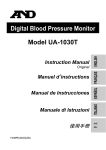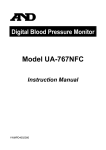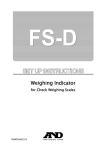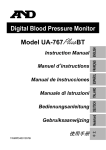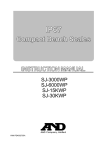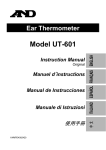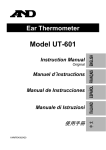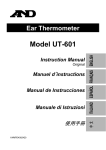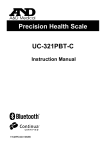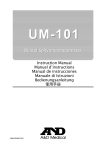Download A&D UA-854 Instruction manual
Transcript
Digital Blood Pressure Monitor Model UA-854 Instruction Manual Manuel d’instructions Manual de Instrucciones Manuale di Istruzioni Bedienungsanleitung 使用手册 1WMPD4001741B Contents Dear Customers.................................................................... 2 Preliminary Remarks ............................................................. 2 Precautions........................................................................... 2 Parts Identification................................................................ 3 Symbols................................................................................ 4 Operation Mode.................................................................... 5 Using The Monitor ................................................................ 6 Installing / Changing The Batteries .................................. 6 Connecting The Air Hose ................................................. 6 Connecting The AC Adapter ............................................. 6 Adjusting The Built-in Clock ............................................ 7 Setting Three Reminders .................................................. 7 Alarm ON/OFF Mark On The Display ................................ 8 Attaching The Arm Cuff ................................................... 8 How To Take Proper Measurements ................................. 8 Measurement ................................................................... 8 After Measurement .......................................................... 8 Measurements ...................................................................... 9 Normal Measurement....................................................... 9 Measurement With The Desired Systolic Pressure ........... 10 Notes For Proper Measurement ...................................... 10 Recalling Memory Data ....................................................... 11 Recalling Memory Data .................................................. 12 Clearing The Memory Data............................................. 12 What Is An Irregular Heartbeat ............................................ 13 Pressure Bar Indicator ......................................................... 13 WHO Classification Indicator ............................................... 13 About Blood Pressure.......................................................... 14 What Is Blood Pressure? ................................................. 14 What Is Hypertension And How Is It Controlled? ............. 14 Why Measure Blood Pressure At Home? .......................... 14 WHO Blood Pressure Classification ................................. 14 Blood Pressure Variations............................................... 14 Troubleshooting ................................................................. 15 Maintenance ....................................................................... 16 Technical Data .................................................................... 16 EMC Table .......................................................................... 17 English 1 Dear Customers Congratulations on purchasing a state-of-the-art A&D blood pressure monitor, one of the most advanced monitors available today. Designed for ease of use and accuracy, this monitor will facilitate your daily blood pressure regimen. We recommend that you read through this manual carefully before using the device for the first time. Preliminary Remarks This device conforms to the European Directive 93/42 EEC for Medical Products. This is made evident by the mark of conformity. (0366: The reference number to the involved notified body) The device is designed for use on adults only, not newborns or infants. Environment for use The device is for use indoors. Precautions Precision components are used in the construction of this device. Extremes in temperature, humidity, direct sunlight, shock or dust should be avoided. Clean the device with a soft, dry cloth. Never use thinner, alcohol, benzine, or wet cloth. Avoid tightly folding the cuff or storing the hose tightly twisted for long periods, as such treatment may shorten the life of the components. The device and cuff are not water resistant. Prevent rain, sweat and water from soiling the device and cuff. Measurements may be distorted if the device is used close to televisions, microwave ovens, cellular telephones, X-ray or other devices with strong electrical fields. Used equipment, parts and batteries are not treated as ordinary household waste, and must be disposed of according to the applicable local regulations. English 2 Parts Identification AM Button PM Button Air Connector Plug MEMORY Button Display Arm Cuff START Button (Orange illumination during the AM) (Blue illumination during the PM) Air Socket Air Hose Battery Compartment 1.5V Batteries (R6P, LR6 or AA) DC Jack Part of Display MEMORY Clock display Day Time Temperature Battery Cover WHO Classification Indicator and Pressure Bar Indicator Battery Indicator Alarm ON/OFF mark Heart Mark English 3 Systolic Pressure Diastolic Pressure Pulse Rate I.H.B. Indicator (Irregular heartbeat indicator) Symbols Symbols Function / Meaning Recommended Action Standby and Turn the device on. Battery installation guide Direct current SN Serial number Date of manufacture 2007 Type BF: Device, cuff and tubing are designed to provide special protection against electrical shocks. The indicator that appears while Measurement is in measurement is in progress. It blinks progress. Remain as still when the pulse is detected. as possible. Irregular Heartbeat indicator. (I.H.B.) The indicator that appears when an irregular heartbeat or any excessive body movement is detected during the measurement. Previous measurements stored in MEMORY. The battery power indicator during Full Battery measurement. Replace all batteries with Low Battery The battery is low when it blinks. new ones, when the mark blinks. Try the measurement again. Unstable blood pressure due to very still during movement during the measurement. Remain the measurement. The systolic and diastolic values are within 10 mmHg of each other. The pressure value did not increase Fasten the cuff correctly, during inflation. and try the measurement again. The cuff is not fastened correctly. PUL. DISPLAY ERROR SYS. DIA. PUL./min. AM PM The pulse is not detected correctly. Systolic blood pressure in mmHg Diastolic blood pressure in mmHg Pulse per minute Time in the morning Time in the afternoon Alarm ON/OFF mark of the reminder EC directive medical device label WEEE label Manufacturer EU-representative English 4 If you want to stop the sound, press any button. Operation Mode 1. Normal Measurement With Storing Data Press the START button. Blood pressure is measured and data is stored within the device. The device can store the last 90 sets of data in memory. M 2. Recalling The Data Press the MEMORY button to recall the data. The average data of all the measurements is displayed, as indicated in the figure at the right. Then, each time the MEMORY button is pressed, the memory data is displayed from the most recent. Averaged systolic Averaged diastolic Number of data Average of all the data Press M For details on recalling data, refer to “Recalling Memory Data” . The device can store the last 90 sets of data in memory. Most recent data: Displays alternately every 3 seconds M 3. Clearing The Data Press and hold the MEMORY button until the “ (memory) mark blinks to clear the stored data. ” 4. Measurement With The Desired Systolic Pressure Refer to page 10 for measurement with the desired systolic pressure. 5. Switching The Unit Of Temperature In the clock setting mode, when the dashes in the temperature displaying area are blinking, press the PM button to select °C or °F. Then, press the AM button or START button to return to the clock display. For details on the clock setting mode, refer to “Adjusting The Built-in Clock” on page 7. English 5 Select the unit of temperature Using The Monitor Installing / Changing The Batteries 1. Slide the battery cover to open it. 2. Remove the used batteries and insert new batteries into the battery compartment as shown, taking care that the polarities (+) and (-) are correct. 3. Slide the battery cover to close it. Use only R6P, LR6 or AA batteries. Step 2 Step 1 Step 3 CAUTION Insert the batteries as shown in the battery compartment. If not, the device will not work. When (LOW BATTERY mark) blinks on the display, replace all batteries with new ones. Do not mix old and new batteries. It may shorten the battery life, or cause the device to malfunction. (LOW BATTERY mark) does not appear when the batteries are drained. Battery life varies with the ambient temperature and may be shorter at low temperatures. Use the specified batteries only. Remove the batteries if the device is not to be used for a long time. The batteries may leak and cause a malfunction. Connecting The Air Hose Insert the air connector plug into the air socket firmly. Air socket Air connector plug Connecting The AC Adapter Insert the AC adapter plug into the DC jack. Then, insert the AC adapter into an electrical outlet. DC jack AC adapter plug English 6 Using The Monitor Adjusting The Built-in Clock Press and hold Adjust the clock prior to use. 1. Press and hold the AM button until the year starts blinking. 2. Select the year using the PM button. Press the AM button to set the current year and move to month/day selection. The date can be set anywhere between the years 2006 and 2056. 3. Select the month using the PM button. Press the AM button to set the current month and move to day selection. 4. Select the day using the PM button. Press the AM button to set the current day and move to hour/minute selection. 5. Select the hour using the PM button. Press the AM button to set the current hour and move to minute selection. Year Month Day Hour Minute Clock Select the unit of temperature Anytime 6. Select the minute using the PM button. (Press the AM button to go to the temperature unit selection mode. For details, refer to page 5.) Press the START button to set the current minute and activate the clock. Press and hold Setting Three Reminders This device has 3 reminder alarms. You can set 3 different reminder alarms within a 24-hour period. 1. Press and hold the AM button until the year starts blinking. Then press the MEMORY button. “P-1” is shown at the bottom of the display. 2. Select the hour using the PM button and press the AM button to set the hour and move to minute selection. Press the PM button to set the minute and press the AM button or the START button to return to the clock display. The mark appears on the display. 3. To set the second and third reminders, press the MEMORY button in the reminder setting mode to display “P-2” or “P-3”. Repeat the above process to set each reminder. English 7 M First buzzer Second buzzer M M Third buzzer Anytime Using The Monitor Alarm ON/OFF Mark On The Display When the alarm is on, a “ ” appears on the LCD. To turn the alarm off, simply press the AM button once. The alarm will sound for 1 minute. To stop the alarm sound, press any button once. Rolled up shirtsleeve Attaching The Arm Cuff 1. Wrap the cuff around the upper arm, about 2-3 cm above the elbow, as shown. Place the cuff directly against the skin, as clothing may cause a faint pulse, and result in a measurement error. 2. Constriction of the upper arm, caused by rolling up a shirtsleeve, may prevent accurate readings. Cuff Air Hose 2 -3 cm Constriction of the Upper Arm How To Take Proper Measurements For the most accurate blood pressure measurement: Sit comfortably at a table. Rest your arm on the table. Relax for about five to ten minutes before measurement. Place the center of the cuff at the same height as your heart. Remain still and keep quiet during measurement. Do not measure right after physical exercise or a bath. Rest for twenty or thirty minutes before taking the measurement. Try to measure your blood pressure at the same time every day. Measurement During measurement, it is normal for the cuff to feel very tight. (Do not be alarmed). After Measurement After measurement, press the START button to return to the clock display. Or the device returns to the clock display automatically one minute after measurement. Remove the cuff and record your data. Note: Allow at least ten minutes between measurements on the same person. English 8 Measurements Model UA-854 is designed to detect the pulse and to inflate the cuff to a systolic pressure level automatically. If your systolic pressure is expected to exceed 230 mmHg, read "Measurement With The Desired Systolic Pressure" on the next page. Normal Measurement 1. Place the cuff on the arm (preferably the left arm). Sit quietly during measurement. 2. Press the START button. The START button illuminates in orange in the morning (AM) and blue in the afternoon (PM). 0 (zero) is displayed blinking briefly. Then the display changes, as indicated in the figure at the right, as the measurement begins. The cuff starts to inflate. It is normal for the cuff to feel very tight. A pressure bar indicator is displayed, on the left edge of the display, during inflation. Note: If you wish to stop inflation at any time, press the START button again. 3. When inflation is complete, deflation starts automatically and (heart mark) blinks, indicating that the measurement is in progress. Once the pulse is detected, the mark blinks with each pulse beat. Note: If an appropriate pressure is not obtained, the device starts to inflate again automatically. 4. 5. When the measurement is complete, the systolic and diastolic pressure readings and pulse rate are displayed. The cuff exhausts the remaining air and deflates completely. At heart level Press START Zero display Starts inflation Pressurizing Measurement in progress Systolic pressure Diastolic pressure WHO classification Pulse rate Exhausts remaining air automatically Press the START button to return to the clock display. Or the device returns to the clock display automatically one minute after measurement Note: Allow at least ten minutes between measurements on the same person. English 9 Measurements Measurement With The Desired Systolic Pressure If your systolic pressure is expected to exceed 230 mmHg, use this procedure. 1. Place the cuff on the arm (preferably the left arm). 2. Press and hold the START button until a number about 30 to 40 mmHg higher than your expected systolic pressure appears. 3. Release the START button to start measurement, when the desired number is reached. Then continue to measure your blood pressure as described on the previous page. At heart level Press and hold the button START Release the button at the desired systolic pressure Refer to the previous page for measurement Notes For Proper Measurement Sit down in a comfortable position. Place the arm to be used for the measurement on a table or other support so that the center of the cuff will be at the same height as your heart. Relax for about five or ten minutes before taking a measurement. If you are excited or depressed by emotional stress, the measurement will reflect this stress as a higher (or lower) than normal blood pressure reading and the pulse reading will usually be faster than normal. An individual's blood pressure varies constantly, depending on what you are doing and what you have eaten. What you drink can have a very strong and rapid effect on your blood pressure. This device bases its measurements on the heartbeat. If you have a very weak or irregular heartbeat, the device may have difficulty determining your blood pressure. Should the device detect a condition that is abnormal, it will stop the measurement and display an error symbol. Refer to page 4 for the description of symbols. This blood pressure monitor is intended for use by adults only. Consult with your physician before using this device on a child. A child should not use this device unattended. English 10 Recalling Memory Data Note: This device stores the last 90 measurements in memory. Clock display 1. Press the MEMORY button. The average data of all the measurements and the number of data are displayed. M Averaged systolic Averaged diastolic Number of data Average of all the data Press 2. Then, each time the MEMORY button is pressed, the memory data is displayed from the most recent. M Systolic Diastolic Pulse rate Most recent data: Displays alternately every 3 seconds M M 3. After the last data is displayed, press the MEMORY button to return to the clock display. Or the device returns to the clock display automatically after one minute. Last data (Oldest) Press M , or after one minute Anytime Clock display English 11 Recalling Memory Data 4. Press the following key to recall various data when the average data of all the measurements is displayed. AM button To recall the average data during the AM. The START button illuminates in orange. Then, each time the AM button is pressed, the memory data taken during the AM is displayed from the most recent. After the last data is displayed, the display returns to the clock display PM button To recall the average data during the PM. The START button illuminates in blue. Then, each time the PM button is pressed, the memory data taken during the PM is displayed from the most recent. After the last data is displayed, the display returns to the clock display START button To display the clock. When the MEMORY button is pressed at each display, the display returns to the average data of all the measurements Clearing The Memory Data 5. Press and hold the MEMORY button until the “ to clear the stored data. English 12 ” (memory) mark blinks What Is An Irregular Heartbeat Model UA-854 blood pressure monitor provides a blood pressure and pulse rate measurement even when an irregular heartbeat occurs. An irregular heartbeat is defined as a heartbeat that varies by 25% from the average of all heartbeats during the blood pressure measurement. It is important that you be relaxed, remain still and do not talk during measurements. Note: We recommend contacting your physician if you see this indicator frequently. Pressure Bar Indicator The indicator monitors the progress of pressure during measurement. Pressurizing Releasing air Inflation in progress Measurement in progress Inflation complete WHO Classification Indicator Each segment of the bar indicator corresponds to the WHO blood pressure classification described on the next page. WHO Classification Indicator Severe hypertension Moderate hypertension Mild hypertension High normal Normal Optimal Example: Moderate hypertension Mild hypertension : The indicator displays a segment, based on the current data, corresponding to the WHO classification. High normal English 13 About Blood Pressure What Is Blood Pressure? Blood pressure is the force exerted by blood against the walls of the arteries. Systolic pressure occurs when the heart contracts. Diastolic pressure occurs when the heart expands. Blood pressure is measured in millimeters of mercury (mmHg). One's natural blood pressure is represented by the fundamental pressure, which is measured first thing in the morning while one is still at rest and before eating. What Is Hypertension And How Is It Controlled? Hypertension, an abnormally high arterial blood pressure, if left unattended, can cause many health problems including stroke and heart attack. Hypertension can be controlled by altering lifestyle, avoiding stress, and with medication under a doctor’s supervision. To prevent hypertension or keep it under control: Do not smoke Exercise regularly Reduce salt and fat intake Have regular physical checkups Maintain proper weight Why Measure Blood Pressure At Home? Blood pressure measured at a clinic or doctor's office may cause apprehension and can produce an elevated reading, 25 to 30 mmHg higher than that measured at home. Home measurement reduces the effects of outside influences on blood pressure readings, supplements the doctor's readings and provides a more accurate, complete blood pressure history. WHO Blood Pressure Classification Standards to assess high blood pressure, without regard to age, have been established by the World Health Organization (WHO), as shown in the chart. Blood Pressure Variations An individual’s blood pressure varies greatly on a daily and seasonal basis. It may vary by 30 to 50 mmHg due to various conditions during the day. In hypertensive individuals, variations are even more pronounced. Normally, the blood pressure rises while at work or play and falls to its lowest levels during sleep. So, do not be overly concerned by the results of one measurement. Take measurements at the same time every day using the procedure English 14 described in this manual to get to know your normal blood pressure. Regular readings give a more comprehensive blood pressure history. Be sure to note the date and time when recording your blood pressure. Consult your doctor to interpret your blood pressure data. Troubleshooting Problem Possible Reason Nothing Batteries are drained. appears on the display, even Battery terminals are not when the power in the correct position. is turned on. The cuff does not inflate. The unit does not measure. Readings are too high or too low. Other Battery voltage is too low. (LOW BATTERY mark) blinks. [ If the batteries are drained completely, the mark does not appear.] The cuff is not fastened properly. You moved your arm or body during the measurement. The cuff position is not correct. The value is different from that measured at a clinic or doctor’s office. Recommended Action Replace all batteries with new ones. Reinstall the batteries with negative and positive terminals matching those indicated on the battery compartment. Replace all batteries with new ones. Fasten the cuff correctly. Make sure you remain very still and quiet during the measurement. Sit comfortably and still. Raise your hand so that the cuff is at the same level as your heart. If you have a very weak or irregular heat beat, the device may have difficulty in determining your blood pressure. Refer to “Why Measure Blood Pressure At Home”. Remove the batteries. Place them back properly and try the measurement again. Note: If the actions described above do not solve the problem, contact the dealer. Do not attempt to open or repair this product, as any attempt to do so will make your warranty invalid. English 15 Maintenance Do not open the device. It uses delicate electrical components and an intricate air unit that could be damaged. If you cannot fix the problem using the troubleshooting instructions, request service from your dealer or from the A&D service group. The A&D service group will provide technical information, spare parts and units to authorized dealers. The device was designed and manufactured for a long service life. However it is generally recommended to have the device inspected every 2 years, to ensure proper functioning and accuracy. Please contact either your authorized dealer or A&D for maintenance. Technical Data Type Measurement method Measurement range Measurement accuracy Temperature unit Temperature accuracy Power supply Classification Clinical test EMC Memory Operating condition Storage condition Dimensions Weight Accessory AC adapter TB-233 UA-854 Oscillometric measurement Pressure: 20 - 280 mmHg Pulse: 40 - 180 beats / minute Pressure: ±3 mmHg or 2%, whichever is greater Pulse: ±5% °C or °F ±2°C (-15°C to +49°C) 4 x 1.5V batteries (R6P, LR6 or AA) or AC adapter (TB-233) (Not included) Type BF According to ANSI / AAMI SP-10 1987 IEC 60601-1-2: 2001 Last 90 measurements +10°C to +40°C / 30%RH to 85 %RH -10°C to +60°C / 30%RH to 85 %RH Approx. 150 [W] x 156 [H] x 126 [D] mm Approx. 500 g, excluding the batteries The adapter is to connect the blood pressure monitor to a power source at home. Please contact your local A&D dealer for purchasing. Note: Specifications are subject to change without prior notice. English 16 Medical Electrical Equipment needs special precautions regarding EMC and needs to be installed and put into service according to the EMC information provided in the following. Portable and mobile RF communication equipment (e.g. cell phones) can affect Medical Electrical Equipment. The use of accessories and cables other than those specified (other than boso original parts) may result in increased emissions or decreased immunity of the unit. Guidance and manufacturer’s declaration – electromagnetic emissions The A&D unit is intended for use in the electromagnetic environment specified below. The customer or the user of the A&D unit should assure that it is used in such an environment. Emissions test Compliance Electromagnetic environment – guidance RF emissions Group 1 The A&D unit uses RF energy only for its CISPR 11 internal function. Therefore, its RF emissions are very low and are not likely to cause any interference in nearby electronic equipment. RF emissions Class B The A&D unit is suitable for use in all CISPR 11 establishments, including domestic Harmonic emissions Class A establishments and those directly connected IEC 61000-3-2 to the public low-voltage power supply Voltage Complies network that supplies buildings used for fluctuations/flicker domestic purposes. emissions IEC 61000-3-3 Recommended separation distances between portable and mobile RF communications equipment and the A&D unit The A&D unit is intended for use in an electromagnetic environment in which radiated RF disturbances are controlled. The customer or the user of the A&D unit can help prevent electromagnetic interference by maintaining a minimum distance between portable and mobile RF communications equipment (transmitters) and the A&D unit as recommended below, according to the maximum output power of the communications equipment. Rated maximum Separation distance according to frequency of transmitter output m power of transmitter 150 kHz to 80 MHz 80 MHz to 800 MHz 800 MHz to 2.5 GHz d = 1.2 P d = 1.2 P d = 2.3 P W 0.01 0.12 0.12 0.23 0.1 0.38 0.38 0.73 1 1.2 1.2 2.3 10 3.8 3.8 7.3 100 12 12 23 For transmitters rated at a maximum output power not listed above, the recommended separation distance d in metres (m) can be estimated using the equation applicable to the frequency of the transmitter, where p is the maximum output power rating of the transmitter in watts (W) according to the transmitter manufacturer. NOTE 1 At 80 MHz and 800 MHz, the separation distance for the higher frequency range applies. NOTE 2 These guidelines may not apply in all situations. Electromagnetic propagation is affected by absorption and reflection from structures, objects and people. English 17 Guidance and manufacturer’s declaration – electromagnetic immunity The A&D unit is intended for use in the electromagnetic environment specified below. The customer or the user of the A&D unit should assure that it is used in such an environment. Immunity IEC 60601 Compliance Electromagnetic environment – test test level level guidance Portable and mobile RF communications equipment should be used no closer to any part of the A&D unit, including cables, than the recommended separation distance calculated from the equation applicable to the frequency of the transmitter. Recommended separation distance: Conducted RF IEC 61000-4-6 Radiated RF IEC 61000-4-3 3 V rms 150 kHz to 80 MHz 3 V/m 80 MHz to 2,5 GHz 3 V rms d = 1.2 P 3 V/m d = 1.2 P d = 2.3 P 80 MHz to 800 MHz 800 MHz to 2,5 GHz where P is the maximum output power rating of the transmitter in watts (W) according to the transmitter manufacturer and d is the recommended separation distance in metres (m). Field strengths from fixed RF transmitters, as determined by an electromagnetic site survey, a should be less than the compliance level in each frequency range.b Interference may occur in the vicinity of equipment marked with the following symbol: NOTE 1 At 80 MHz and 800 MHz, the higher frequency range applies. NOTE 2 These guidelines may not apply in all situations. Electromagnetic propagation is affected by absorption and reflection from structures, objects and people. a b Field strengths from fixed transmitters, such as base stations for radio (cellular/cordless) telephones and land mobile radios, amateur radio, AM and FM radio broadcast and TV broadcast cannot be predicted theoretically with accuracy. To assess the electromagnetic environment due to fixed RF transmitters, an electromagnetic site survey should be considered. If the measured field strength in the location in which the A&D unit is used exceeds the applicable RF compliance level above, the A&D unit should be observed to verify normal operation. If abnormal performance is observed, additional measures may be necessary, such as re-orienting or relocating the A&D unit. Over the frequency range 150 kHz to 80 MHz, field strengths should be less than 3 V/m. English 18 Guidance and manufacturer’s declaration – electromagnetic immunity The A&D unit is intended for use in the electromagnetic environment specified below. The customer or the user of the A&D unit should assure that it is used in such an environment. Immunity test IEC 60601 test level Compliance level Electromagnetic environment – guidance Electrostatic discharge (ESD) IEC 61000-4-2 ± 6 kV contact ± 8 kV air ± 6 kV contact ± 8 kV air Electrical fast transient/burst IEC 61000-4-4 ± 2 kV for power supply lines ± 1 kV for input/output lines n.a. Surge IEC 61000-4-5 ± 1 kV differential mode ±2 kV common mode ± 1 kV differential mode ±2 kV common mode Mains power quality should be that of a typical commercial or hospital environment. Voltage dips,short interruptions and voltage variations on power supply input lines IEC 61000-4-11 < 5% UT (> 95% dip in UT) for 0.5 cycle 40% UT (60% dip in UT) for 5 cycles 70% UT (30% dip in UT) for 25 cycles < 5% UT (> 95% dip in UT) for 5 s < 5% UT (> 95% dip in UT) for 0.5 cycle 40% UT (60% dip in UT) for 5 cycles 70% UT (30% dip in UT) for 25 cycles < 5% UT (> 95% dip in UT) for 5 s Mains power quality should be that of a typical commercial or hospital environment. If the user of the A&D unit requires continued operation during power mains interruptions, it is recommended that the A&D unit be powered from an uninterruptible power supply or a battery. Power frequency (50/60 Hz) magnetic field IEC 61000-4-8 3 A/m 3 A/m Floors should be wood, concrete or ceramic tile. If floors are covered with synthetic material, the relative humidity should be at least 30%. NOTE : UT is the AC mains voltage prior to application of the test level. English 19 A&D Company, Limited 1-243 Asahi, Kitamoto-shi, Saitama 364-8585 JAPAN Telephone: [81] (48) 593-1111 Fax: [81] (48) 593-1119 EC REP A&D INSTRUMENTS LTD. Unit 24/26 Blacklands Way, Abingdon Business Park, Abingdon, Oxfordshire OX14 1DY United Kingdom Telephone: [44] (1235) 550420 Fax: [44] (1235) 550485 A&D Australasia Pty Ltd. 32 Dew Street, Thebarton, South Australia 5031 AUSTRALIA Telephone: [61] (8) 8301-8100 Fax: [61] (8) 8352-7409 A&D ENGINEERING, INC. 1756 Automation Parkway, San Jose, California 95131 U.S.A. Telephone: [1] (408) 263-5333 Fax: [1] (408)263-0119 A&D KOREA Limited 한국에이.엔.디(주) 대한민국 서울시 영등포구 여의도동 36-2 맨하탄 빌딩 8층 ( 8th Floor, Manhattan Bldg. 36-2 Yoido-dong, Youngdeungpo-ku, Seoul, KOREA ) Telephone: [82] (2) 780-4101 Fax: [82] (2) 782-4280





















